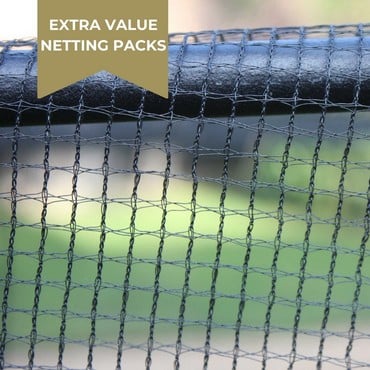COMMON GARDEN PESTS – A QUICK GUIDE TO THE BIG FOUR
Unfortunately the vegetables you’re attempting to grow for your own consumption are also much loved by lots of pests which exist in your garden. From the smallest whitefly and aphids right up to pigeons, rabbit and even deer – all are out for a piece of the action and if you don’t protect against them, you won’t have a crop to harvest! If you can see the bigger picture, you can’t help but be fascinated by the way the different ecosystems and food chains interact, but for now it’s the smaller picture of your garden crops we’re concentrating on and the most common garden pests.
Aphids
WHAT THEY DO AND HOW TO RECOGNISE THEM
Sap-sucking mainstays of the garden pest world mainly greenfly and blackfly. With hundreds of species of aphids, there are very few garden plants or vegetables which can escape their unwanted attention. As they suck sap from plants, viruses are transmitted and moulds develop on the honeydew they excrete. Aphids can be green, black, red, pink and various other colours and are roughly 2mm long. An idea what you’re up against, a single aphid could in theory produce ten million tonnes of offspring in 100 days of summer breeding!
TREATMENT
Luckily, aphids have many natural predators. The humble ladybird is a much loved companion of the gardener, due to its fondness for aphids. Both adult ladybirds (adalia bipunctata) and larvae love nothing more than dining out on this prevalent pest, and are capable of consuming large numbers each day. Lacewings and hoverfly larvae also dine out at the aphid cafe along with various beetles. Attracting pest predators such as these could turn out to be the best thing you do in the garden.
ANY OTHER INFO...
Keeping plants healthy and not too soft and green and cultural tricks like pinching out broad bean tops before the aphids arrive.
Resolva Natural Power Bug and Mildew control works by physical action to give safe and effective control of a wide range of plant pests and mildew. Controls:Whitefly, greenfly, blackfly, spider mites, mealybugs, mealy cabbage, aphid, scale insects, psyllids and powdery mildew
Whitefly
WHAT THEY DO AND HOW TO RECOGNISE THEM
The scourge of greenhouse gardeners, the presence of whitefly is indicated by white scales on the underside of the leaves and quite often, a white cloud of flies will take to the air if an infested plant is touched. Affected plants can develop viruses and sooty mould. Adult whitefly are 2mm long small insects with white wings, and they lay eggs on the underside of leaves.
TREATMENT
Whitefly will recoil in horror at the mention of a tiny parasitic wasp named encarsia formosa. The wasp will lay its eggs directly into the whitefly scale; the eggs then hatch and feed on the pupating whitefly inside, turning the scale black before the adult encarsia emerges. Lacewings, ladybird and even a few small birds are all partial to the scales so help is at hand!
ANY OTHER INFO...
Hanging sticky traps in the greenhouse will snare adults on the wing; regularly applying organic sprays doesn’t do them any favours.
Slugs & Snails
WHAT THEY DO AND HOW TO RECOGNISE THEM
Slug damage can be recognised by the irregular holes with smooth edges they make on leaves and nearby will be evidence of their slime trials. They are particularly fond of succulent seedlings, which when left unprotected, can be totally destroyed in a single night.
As well as attacking the leafy parts of plants, slugs will also feast on your fruit and vegetable crop. Slugs will chew holes in your ripening strawberries and tomatoes. Potatoes are particularly vulnerable, since they are attacked without the slugs having to leave the safety of being underground.
TREATMENT
The nematode phasmarhabditis hermaphrodita likes slugs as much as gardeners hate them! The nematodes will actively seek out the slugs below ground, enter their body and spread bacteria, which causes the slug to stop feeding and perish. The good news doesn’t end there – frogs, toads, hedgehogs and birds are all partial to slugs and snails and will happily devour them all night long
ANY OTHER INFO...
You’ll never rid the garden of slugs completely but you can reduce the population significantly with the various traps, nematodes and natural predators around. Supplement their efforts with organic slug pellets, resistant potato cultivars and you own moonlit sorties to remove them by hand. Chemical slug pellets should be a last resort; they are harmful to pets and children and remain in the food chain, affecting all manner of creatures
Caterpillars
WHAT THEY DO AND HOW TO RECOGNISE THEM
The larvae of various moths and butterflies, caterpillars cause extensive damage to both vegetables and tree fruit. The cabbage white larvae in particular is infamous for decimating brassica plants, whilst the codling moth caterpillar has no qualms about ruining entire apple crops on single trees or throughout orchards.
TREATMENT
Midnight forays with your torch are a good way to keep down caterpillar numbers – squash and offenders you find and destroy egg clusters as well. Along with the nematodes, you can apply various organic contact sprays, but the most effective way to protect your brassicas with butterfly netting in the first place to stop the invasion of cabbage white and the inevitable laying of their eggs.
ANY OTHER INFO...
Caterpillars as a rule are voracious feeders and many of them are among the most serious of horticultural pests.




























